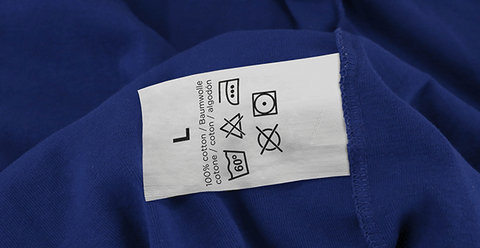
General tips:
- Separate your laundry by color. Put dark with dark, white with white and color with color.
- To stop color from fading: Check whether a garment will fade or not by placing a piece of white cloth underneath it while it's still damp and passing a hot iron over it. If the color comes through, you know you need to hand-wash it separately in lukewarm soapy water. New garments should always be washed separately the first time (using washing powder!) to get rid of surplus coloring. And never leave wet washing in a pile: the colors could run and stain other garments!
Cotton
Made from the fluffy fibers of the cotton plant, most cotton fabrics are preshrunk. That is an organic fabric.
How to wash: Machine-wash in cold or warm with all-purpose detergent.
Drying: Don't dry linen in the sun or in a tumble-dryer to prevent it from shrinking.
Tip: Sun yellows it; line-dry in shade.
Synthetics
Synthetic fabrics are textiles made from man-made rather than natural fibers.
Polyester, nylon, spandex, acrylic, and acetate won’t shrink and will resist water-based stains.
Synthetic fabrics have many different qualities—including some not achievable with natural fibers. Synthetic fibers can provide waterproof fabrics and elastic fabrics for swimwear and lingerie. Depending on the synthetic fabric, various added chemicals can make it softer, wrinkle-free, flame-resistant, water-resistant, stain-resistant, or moth-repellent. Most produce static and may permanently wrinkle in a hot dryer, so dry on low.
How to wash: Machine-wash in warm with all-purpose detergent.
Tip: Use fabric softener to curb static.
Viscose
Viscose is a semi-synthetic material containing natural fibers treated with chemicals.
Machine-washing: Wash viscose clothing inside out at a maximum of 40°C on a delicate programmed. Your machine should be two-thirds full.
Drying: Dry on a hanger (never tumble-dry) and iron while still slightly damp.
Wool
Woven from the undercoats of sheep, goats, and other hairy mammals, wool is ultra-durable. But it shrinks in warm water, so take precautions.
How to wash: Dry-clean or hand-wash in cold with mild detergent. Air-dry.
Hand-washing: Wash wool at a maximum temperature of 30° using special wool washing products and without soaking. Scrub gently and rinse with lukewarm water, gently squeezing the water out, then rinse in cold water.
Drying: Dry using a towel (without twisting) and then dry flat on a fresh towel.
Tip: Use cedar hangers to repel moths.
Silk
Made from protein fibers produced by silkworms, this durable, luxurious fabric is treated with sizing and may have dyes that bleed.
How to wash: Dry-clean or hand-wash in cold with mild detergent. Air-dry.
Drying: Silk shouldn't be twisted or rough-dried. Spread it flat on a towel or sponge to dry. Shirts and blouses can be dried on a hanger.
Ironing: Iron while still damp.
Tip: Test for colorfastness (dip a cotton swab in detergent and hold it in an inconspicuous area for two minutes to see if the color bleeds).
Rayon
Created from wood pulp treated with chemicals, cool and comfortable rayon is considered a semi-synthetic fabric. When laundered, it may bleed, shrink, or lose its crispness.
How to wash: Dry-clean or hand-wash in cold with mild detergent. Air-dry.
Tip: Iron it when slightly damp.
Linen
Linen, woven from fibers of the flax plant, is sometimes treated with sizing, a finish that makes it crisp. It wrinkles very easily and requires ironing.
How to wash: Dry-clean or hand-wash in cold with mild detergent. Air-dry.
Drying: Don't dry linen in the sun or in a tumble-dryer to prevent it from shrinking.
Tip: Or machine-wash on gentle.
Cashmere
Even if cashmere doesn't get dirty or smell of sweat easily, it should still be washed (after 3 outings). Cashmere is very delicate and the less often it's washed, the longer it lasts.
Machine washing: Pop your cashmere in a special underwear bag or in a pillowcase in your machine and use special wool washing products. Select a cold wool programme and don't spin at over 600 rpm.
Hand washing: Use wool washing product or diluted shampoo. Don't leave cashmere to soak for too long in your washing water; it should be washed and rinsed fast. Rinse carefully in cold water until it runs clear.
Drying: Dry without twisting. Roll your cashmere in a towel and then dry it flat on a dry towel. Never tumble-dry it.
Ironing: If you need to iron cashmere, don't use a very hot iron. Iron cashmere carefully on the underside.